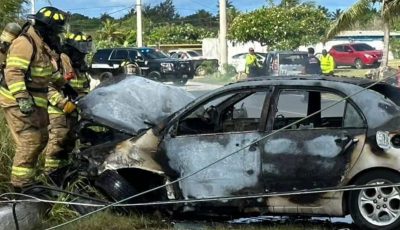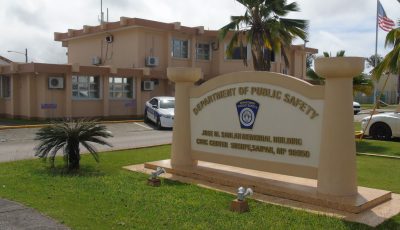Romero’s 911 call played in court
Castro says she is absolutely sure it’s Crisostomo’s voice in 911 call
The dramatic recording of the 911 call that murdered bartender Emerita “Emie” Romero made in the early morning hours of Feb. 5, 2012, was played twice yesterday in the ongoing jury trial in Superior Court of Joseph A. Crisostomo.
“Please help me!” screamed Romero as she cried and begged for her life.
Joanne Deleon Guerrero Castro also testified yesterday that she is absolutely sure it was her former common-law husband Crisostomo’s voice in Romero’s 911 call that investigators asked her to listen to on Feb. 17, 2012.
“It gives me goose bumps all over my body,” said the 38-year-old Castro when interim chief prosecutor Brian Flaherty asked how she reacted upon listening to the 911 recording.
Flaherty and defense counsel Janet H. King both played the unenhanced 911 recording in court during their examination of police officer Sandy Hambros, who was in the Department of Public Safety’s dispatcher room in Susupe when the call was made.
Hambros said he was in the dispatcher room as field supervisor on Feb. 5, 2012, at about 3am when they received an incoming 911 call about someone in need of help.
He said night shift dispatcher Loni Perry asked him to monitor the emergency call and then transferred the line to him. Hambros said when he picked up the phone he overheard the voice of a woman and a man.
Flaherty then played in court the unenhanced recording of the 911 call.
In the recording, Romero is crying, repeatedly begging someone to release her, and asking for help. She also mentioned her location as Marianas Resort. A man’s voice can be heard talking to Romero in a low and calm manner.
Romero at one point screamed “Please help me!”
Hambros’ voice can also be heard in the recording, saying, “Hello, hello” and asking for Romero’s location. He also stated “Marianas Resort,” repeating what the victim mentioned.
Crisostomo appeared emotionless when the recording was played. The eight jurors looked attentive as they listened to the recording.
When the recording was done after two minutes, Flaherty resumed his direct examination of Hambros.
Hambros said that after receiving the call, he immediately sent patrol officers to the northern part of the island. He said he and police officer Jess Wabol also went to the Marpi area aboard one patrol car and dispatched two other police officers to the area.
Hambros said he and Wabol first checked Mariana Resort, then the Kan Pacific swimming pool, Wing Beach, Last Command Post, and other areas in Marpi.
He said by the Cow Town area they saw another vehicle behind them so they pulled over to the side to let the vehicle pass them. The vehicle, however, stopped, made a U-turn, and changed direction. He said they followed the vehicle but lost sight of it.
He said one officer was in the area of the former La Fiesta Mall, waiting to block any incoming southbound vehicles.
When they didn’t find anything, Hambros said they went back to DPS Susupe, where they passed the information to the incoming shift about what happened.
Hambros said he then went home, the following day he took a leave, and when he reported back to DPS he learned that the body of the 911 caller had been found at the former La Fiesta Mall.
“I feel disturbed,” said the officer when asked how he felt after learning that Romero had been found dead.
On cross-examination, King stated that she would play again the 911 call that lasted two minutes and a half. The second play of the recording appeared to be clearer to listeners as King stopped the recording a couple of times and announced the time lapse, then asked Hambros about the three voices that could be heard.
One minute into the recording, King said the female caller could be heard saying, among other things, that she was putting on her pants. King then asked Hambros where was he at that time. He replied that he was trying to get more information from the caller.
Hambros said he stated Marianas Resort in the recording to ask himself about the caller mentioning the area.
Testifying for the CNMI government, Joanne Castro said she was disgusted and had goose bumps when she listened to the recording because she could hear the victim screaming and Crisostomo’s voice in it.
“She was screaming, begging for her life, begging [him] not to hurt her. But he was relaxed,” Castro said.
Castro said that’s how Crisostomo was when he was beating her when they were still living together. “He doesn’t care if he’s hurting me!” she said.
Castro said she tried to cover her ears after she heard the recording because she doesn’t like to hear it again, but the investigators played it again.
Castro said Crisostomo was telling Romero in the recording that he’s sorry and asked her to keep still.
Castro recalled that Federal Bureau of Investigation special agent Joseph Auther asked her about a certain word in the male voice. She said she tried to correct Auther that what Crisostomo was saying was that he’s sorry.
Castro said that Crisostomo is her former boyfriend and the father of her three children. They lived together for 16 to 17 years. She said their relationship started in March 1991 and ended in December 2006.
When asked about their relationship, Castro said there were good times, but there was also a lot of abuse, both mental and physical.
Castro said that Crisostomo used to have a driver’s license but it expired when he was in prison. Associate Judge Joseph N. Camacho later instructed the jury to disregard this statement.
Castro said she saw in the news about a recovered body at the La Fiesta Mall so she called police detective Elias Q. Saralu and informed him about a rental car that Crisostomo had driven.
Castro said it was a Saturday night, Feb. 4, 2012, when Crisostomo came near her current boyfriend’s mother’s house in San Antonio aboard a rental car that fits the description that she saw in the news. She said Crisostomo was there between 8pm and 9pm.
She said when she saw the car stop, she got out of the garage and saw her 15-year-old daughter talking with someone in the vehicle. When the car left, Castro asked her daughter who was she talking to. Castro said her daughter stated that it was her father Crisostomo, who was with his sister, Annie, and Annie’s boyfriend, Cheyenne Sablan.
Castro described the car as having a dark color or greenish and either a Toyota Corolla or Toyota Yaris and that it was tinted.
Castro said she knew it was a rental car because she knew Crisostomo and Annie don’t have a car and that Annie later told her they rented it.
Castro said she called detective Saralu because the car fits the descriptions given by DPS in the media about the suspect’s vehicle. She said she talked with Saralu because he is her nephew and that she’s comfortable with him and worked with him before as a confidential informant.
Castro said she told Saralu about the car that was described in the news and the vehicle that she saw being used by Crisostomo, Annie Crisostomo, and Sablan. Castro said she urged Saralu to check car rental companies.
She recalled that on Feb. 17, 2012, she was in a store when Saralu came and asked her to go to the DPS Criminal Investigation Bureau office on Capital Hill. Castro said she and her boyfriend later proceeded to CIB where they met Saralu and other police officers.
Castro said she was taken to a room with Saralu and police detective Simon Manacop. FBI special agent Auther later arrived and talked to her. Castro said they then asked her to listen to the 911 recording.
Castro said at that time, Feb. 17, she didn’t know about a reward for giving information to DPS about Romero’s murder. She admitted that she later asked if she could get the Crime Stoppers Program’s reward. She was informed, though, that she’s not qualified for the reward because her identify is known.
Castro said that because of the incident, she is now very afraid of going out at night. She said she’s afraid that someone would try to prevent her from testifying in court.
When asked by Flaherty how sure she is that it’s Crisostomo’s voice in the 911 call and how would she rate her sureness on a scale 1 to 10, with 10 being the highest, she replied: “10. I’m absolutely sure that’s Crisostomo.”
King extensively grilled Castro about the latter calling businesses and former chief prosecutor Shelli Neal about the cash reward, amounting to $22,500, for providing information about the crime.
Castro admitted to calling Godfather’s Bar and also speaking to Neal about the reward money but added, “I’m just here to tell the truth on what I knew. I don’t care about the reward money.”
Castro denied she was only after the reward. “I don’t care about the reward. I’m doing this because someone got killed!” said Castro, who appeared agitated at King’s line of questioning.
Before Castro’s testimony, Castro’s 15-year-old daughter with Crisostomo also took the witness stand for the government. She said she does not see her father often.
She said it was in the evening of Feb. 4, 2012, when she saw her father aboard a car at her grandmother’s house in San Antonio. She described the car as a Toyota Corolla being driven by her dad. In the front passenger side was Cheyenne Sablan and in the back was her aunt, Annie.
The daughter said her aunt asked her to come inside the car and handed her $20. She said her father only said “hi” to her.
The daughter said that when they left, her mother asked her who was in the car so she told her it was her father Crisostomo, Annie, and Sablan.
The daughter said she does not remember the last time she saw her father before that night.
DPS dispatcher Loni Perry also testified, saying she was on duty when a female called 911 on the early morning of Feb. 5, 2012. Perry said the woman was distraught and crying. Perry said the woman was not talking to her and instead was asking a male person to let her go. Perry said the woman was begging to be let go. Perry overheard the woman stating that her neck had been hurt.
The dispatcher said the male voice told the woman: “It’s okay, it’s okay. I’ll take you home.”
Perry said the male voice asked for the woman’s name, and she replied, “Emie.”
Perry said she later connected the phone line to Hambros, as he was the supervisor and that she thought it was a missing person case.
Perry said she was scared.
Perry said the male voice was local and the female voice was Filipina.
Hambros’ phone was connected to a recording system. The 911 recording that was played in court was only the portion when Hambros picked up the phone. Perry said that Hambros listened for a while then sent police officers to the Mariana Resort area.
Perry said she dialed the woman’s cellphone number, 989-4425, several times but that it went straight to a voice mail.
She agreed with King on cross-examination that the woman in the 911 call made at 3:02am was crying and screaming for help. Perry said she was not sure how long she had the phone before transferring it to Hambros.
King said the total time the call was made was 4 minutes and the recorded call was 2 minutes and a half, leaving Perry with 1 minute and 30 seconds.
Perry said she listened to the call and tried to talk to the woman, but it appeared that she could not hear her.
The trial will continue today, Thursday, at 8:30am.



























